Diabetes insipidus is a chronic disorder. It makes you really thirsty and urinate a lot of very dilute urine. This happens when your body lacks antidiuretic hormone (ADH) or can’t respond well to it. It leads to a lot of bathroom trips, always feeling thirsty, and dehydration.
You should know the symptoms, causes, how it’s diagnosed, and treatment choices for diabetes insipidus. This knowledge is key to living well with this condition.
Key Takeaways:
- Diabetes insipidus is a chronic disorder characterized by excessive thirst and the excretion of large amounts of diluted urine.
- Symptoms of diabetes insipidus include frequent urination, excessive thirst, and dehydration.
- Causes of diabetes insipidus can range from damage to the hypothalamus or pituitary gland to head trauma, certain medications, and genetic factors.
- Diagnosis of diabetes insipidus typically involves water deprivation tests, urine and blood tests, and imaging studies.
- Treatment options for diabetes insipidus include medications such as desmopressin, lifestyle modifications, and, in rare cases, stem cell therapy.
Types of diabetes insipidus
It is important to know there are different types of diabetes insipidus. The main kinds are central and nephrogenic diabetes insipidus.
Central Diabetes Insipidus
Central diabetes insipidus happens when the hypothalamus or pituitary gland get damaged. This leads to not enough antidiuretic hormone (ADH) being made.
ADH is needed for the body’s water balance. Less ADH means the kidneys don’t keep enough water, causing too much urine and more trips to the bathroom.
This type can be caused by head injuries, tumors, or surgery on the brain. Certain infections or genetics may also be a factor.
Nephrogenic Diabetes Insipidus
Nephrogenic diabetes insipidus is about the kidneys not responding well to ADH. They can’t hold water back or concentrate urine properly.
Like central diabetes insipidus, too much low-concentration urine is produced. This type can come from taking certain drugs like lithium. It can also be due to genetic issues with kidney ADH response.
| Type of Diabetes Insipidus | Description |
|---|---|
| Central Diabetes Insipidus | Occurs due to damage to the hypothalamus or pituitary gland, resulting in insufficient production of ADH. |
| Nephrogenic Diabetes Insipidus | Occurs when the kidneys do not respond properly to ADH, impairing water reabsorption and concentration of urine. |
Knowing about the different types of diabetes insipidus is key. It helps doctors diagnose and treat the condition correctly. They look at a person’s symptoms, history, and tests to pinpoint the type and plan the best care.
Symptoms and diagnosis of diabetes insipidus
Diabetes insipidus brings frequent urination, excessive thirst, and dehydration. It’s when the body can’t balance water properly, causing too much urine. This leads to losing lots of fluids.
The water fasting test is a key step in diagnosing it. A patient quits drinking water for some time and is watched closely. Tests check how much urine is made and the blood’s sodium levels. This shows if the body is handling water right.
Other tests like urine analysis, blood tests, and imaging studies help too. They find if the cause is missing antidiuretic hormone (ADH) or a kidney issue. Understanding the root cause is crucial for proper treatment.
Water Fasting Test Process
The water fasting test helps see water conservation skills. Patients stop drinking water for a while, mainly at night. In the morning, tests check things like urine amount and salt in the blood.
While water is off limits, urine and blood checks keep happening. This is to watch the body’s salt and water balance.
After hours without water, a fake ADH might be given to see how the body reacts. The test ends when urine can hold enough salt or other tests show the problem.
This detailed test, combining with other checks, helps pinpoint diabetes insipidus. It’s key to starting the best treatment for the patient.
| Symptoms of Diabetes Insipidus | Diagnostic Tests for Diabetes Insipidus |
|---|---|
|
|
Treatment options for diabetes insipidus
The right treatment for diabetes insipidus varies by its cause and how bad it is. People with central diabetes insipidus might get better with desmopressin. This drug acts like antidiuretic hormone (ADH) in our bodies, keeping fluids in check.
Making changes to your daily life is key when facing diabetes insipidus. It’s vital to drink plenty of water to avoid dehydration and keep your system balanced. Watching how much you drink and adjusting it as needed based on what you do and the weather can really help manage the disease.
Sometimes, stem cell therapy could be an option for those with this condition. This therapy tries to fix or swap out any broken cells in the brain area that control ADH. But, more studies are necessary to know if it’s truly effective and safe.

